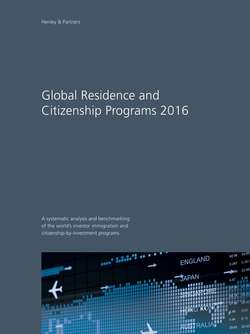Читать книгу Global Residence and Citizenship Programs 2016 - Henley & Partners - Страница 11
The Growing Market for Citizenship and Residence: A Policy Perspective
ОглавлениеMadeleine Sumption
Migration Observatory
University of Oxford
Oxford/UK
A growing number of countries now offer immigrant investor programs, exchanging residence rights or citizenship for a sizeable investment in their economies. From ‘cash-for-citizenship’ to incentives to invest in private sector businesses or property, the market for investor immigration has become increasingly diverse.
But how much value are governments getting from the programs? In theory, the benefits of investor programs for the countries that offer them are straightforward. Destination governments can use them to generate revenues for social programs, infrastructure, or paying down the deficit. They can also use them to attract job-creating investments in the private sector. For small countries, the proceeds from investor programs can be considerable.
In practice, policymakers have often found the results disappointing. While small countries with large investor programs can raise substantial funds, investors’ activities in larger countries that have also embraced the programs — like the US or the UK — are a drop in the ocean compared to the size of their economies.
Designing programs to maximize economic benefits can be a challenge, and rigorous empirical evidence on their impacts is usually absent. The UK gives residence rights to investors who purchase ordinary, interest-bearing government bonds — a transaction whose benefits to the UK economy are close to zero. Several European countries, like Latvia, Portugal, and Spain simply require investors to buy residential property. The impacts of these transactions are also likely to be quite limited (barring some concentrated benefits for realtors and agents). Programs that require private-sector business investments, like the US EB-5 visa, are somewhat more promising. But even this model’s impacts are hard to assess. Policies have only limited influence over how money is invested and whether investments actually create the expected number of jobs — especially since applicants can withdraw their investments as soon as they qualify for permanent residence or citizenship.
The clearest economic benefits come from programs that encourage cash payments to the government or national development funds. While there is no guarantee that governments will spend this money wisely, this model has two advantages over the alternative options. Governments know exactly where the money is going and what is being done with it, and non-refundable donations cannot be withdrawn a few years later. However, the simple transparency of this model makes it controversial and unpopular, accentuating public concerns about whether it is appropriate to ‘sell citizenship’.
Not all investor programs can accurately be described as ‘immigration’. Some impose no requirement to spend any time in the country, while others require only minimal visits of a few days per year. Such programs are often marketed for the access they provide to visa-free travel in other countries. Notable examples include the citizenship-by-investment programs in St. Kitts and Nevis and a handful of other Caribbean countries, which have relatively good access to visa-free tourist and business travel worldwide. Most would struggle to attract applicants if they actually required investors to live in their country.
Countries with minimal residence requirements have to be careful to protect their programs’ reputations. Screening procedures to weed out applicants with criminal backgrounds or illegally obtained wealth help to reduce reputational risks which — in a worst case scenario — could make other countries unwilling to offer visa-free travel to a country’s citizens. This screening is much more thorough than most countries require for their tourist or business visas; but has inherent limits and the risk of bad apples entering through the program cannot be eliminated entirely.
Where next for investor programs? Growing demand from the world’s new wealthy classes, particularly in China, seem likely to fuel investor immigration for the foreseeable future. As governments rush to introduce new programs, learning from other countries’ experiences will be important. Popular destinations with longstanding programs, like Australia and Canada, have recently reassessed their policies for good reasons, including looking for ways to admit immigrants who make more active economic contributions. As governments continue to review their immigrant investor routes and as new countries enter the market, their challenge will be to maintain the programs’ integrity and reputation while demonstrating their economic value much more clearly.
Ms. Sumption is the Director of Research for the International Program at the Migration Policy Institute (MPI) — an independent research institute with offices in Washington D.C. and Brussels. Ms. Sumption oversees the International Program’s research agenda and leads MPI’s work on the economics of immigration. Her research focuses on the design and implementation of work-based visa policies, investor residence and citizenship, and the economic impacts of immigration policies in Europe, North America, and other high-income countries. Her other areas of expertise include immigrants’ labor-market integration and international cooperation on mobility (including free movement and the recognition of qualifications). She is also a nonresident fellow with the Migration Policy Institute Europe.
Ms. Sumption recently published a policy overview of investor residence programs, Selling Visas and Citizenship: Policy Questions from the Global Boom in Investor Immigration, which is available at migrationpolicy.org/research/selling-visas-and-citizenship-policy-questions-global-boom-investor-immigration
Other recent publications include Remaking the US Green Card System (co-author); Rethinking Points Systems and Employer-Selected Immigration (coauthor); Policies to Curb Illegal Employment; Projecting Human Mobility in the United States and Europe for 2020 (Johns Hopkins, coauthor); Migration and Immigrants Two Years After the Financial Collapse (BBC World Service and MPI, co-editor and author); Immigration and the Labor Market: Theory, Evidence and Policy (Equality and Human Rights Commission, co-author); and Social Networks and Polish Immigration to the UK (Institute for Public Policy Research).
